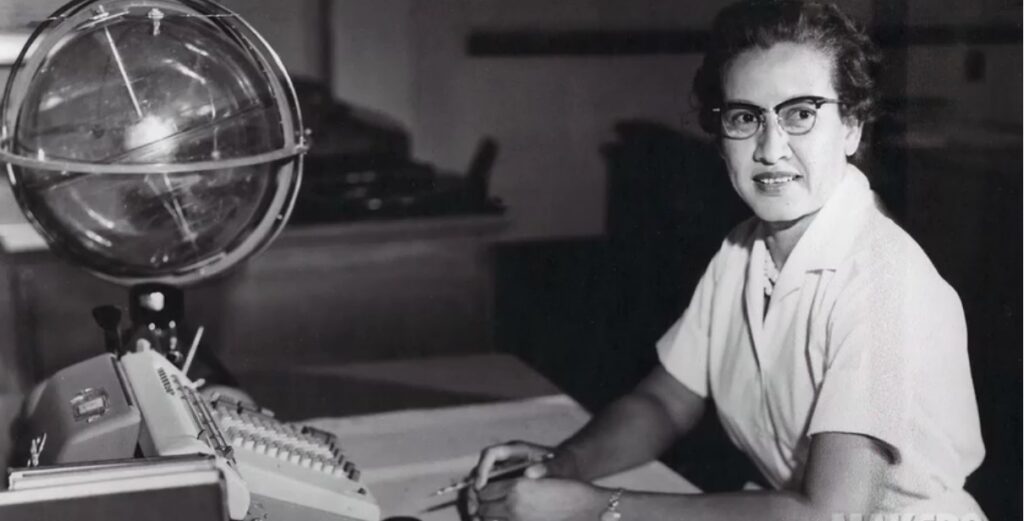Introducing – Katherine Johnson
Katherine Johnson was born on August 26th, 1918 in White Sulphur Springs, West Virginia. The youngest of four children, Johnson was extremely gifted in mathematics – so much so that after starting college at the age of 14, she took every course in mathematics offered by West Virginia State College. One of Johnson’s mentors, W.W. Schieffelin Claytor, just the third African-American to receive a Ph.D. in mathematics, actually added new mathematics courses so that Johnson could continue her learning.
Graduating with degrees in mathematics and French, at the age of 18, Johnson proceeded to take on a teaching position at a Black public school. Just two years later, though, Johnson left this teaching job to enroll in a graduate math program, becoming the first African-American woman to attend graduate school at West Virginia University.

Katherine Johnson and NASA
Though Johnson didn’t finish the program, choosing to focus on her family life instead for a while, she eventually decided to continue her career as a research mathematician. Hopping back into the world of teaching for a while, Johnson accepted a position with the National Advisory Committee for Aeronautics (the agency which preceded NASA) in June of 1953.
Originally working in a “pool” of women (working a job referred to, at that time, as a “Computer“) who were tasked with performing math calculations, Johnson quickly proved to those around her that she belonged. She felt particularly vindicated when a specific question was asked and an engineer said, “I’ll have to ask Katherine about that.”
With a specialty in calculating trajectories for space shots which determined the timing for launches, Johnson correctly computed the “launch window” for astronaut Alan Shepard’s Mercury mission. Thanks to Johnson, Shepard had a successful splashdown at sea on May 5th, 1961 which marked the return of the first American in space.
Katherine Johnson was a “Computer” when Computers Wore Skirts
From 1958 until her retirement in 1986, Johnson was routinely called upon to verify calculations and numbers provided by computers which were being used for the first time(s):
“In 1962, as NASA prepared for the orbital mission of John Glenn, Johnson was called upon to do the work that she would become most known for. The complexity of the orbital flight had required the construction of a worldwide communications network, linking tracking stations around the world to IBM computers in Washington, Cape Canaveral in Florida, and Bermuda. The computers had been programmed with the orbital equations that would control the trajectory of the capsule in Glenn’s Friendship 7 mission from liftoff to splashdown, but the astronauts were wary of putting their lives in the care of the electronic calculating machines, which were prone to hiccups and blackouts. As a part of the preflight checklist, Glenn asked engineers to “get the girl”—Johnson—to run the same numbers through the same equations that had been programmed into the computer, but by hand, on her desktop mechanical calculating machine. “If she says they’re good,’” Katherine Johnson remembers the astronaut saying, “then I’m ready to go.” Glenn’s flight was a success, and marked a turning point in the competition between the United States and the Soviet Union in space.”
Source: NASA – Katherine Johnson Biography

Katherine Johnson’s Achievements
Throughout her life, Johnson co-authored 26 scientific papers. When she was awarded her Presidential Medal of Freedom in 2015, President Barack Obama cited Johnson as a pioneering example of African-American women in STEM, stating, “”Katherine G. Johnson refused to be limited by society’s expectations of her gender and race while expanding the boundaries of humanity’s reach.”
A recipient of NASA’s Lunar Spacecraft and Operation’s Group Achievement Award and NASA’s Apollo Group Achievement Award, NASA also noted Johnson’s “historic role as one of the first African-American women to work as a NASA scientist.”
Katherine Johnson passed away on February 24th, 2020 at the age of 101. In her honor, NASA dedicated the Katherine G. Johnson Computational Research Facility at the Langley Research Center to commemorate the hard work she did to help take them to the stars.
I’ll Leave you with This:
Katherine Johnson is the second representative of Magnetic Mobile’s celebration of Women’s History Month. Throughout her long and fulfilling life, Johnson was an absolute trailblazer.
Upon Johnson’s passing, NASA Administrator, James Bridenstine said the following:
“Our NASA family is sad to learn the news that Katherine Johnson passed away this morning at 101 years old. She was an American hero and her pioneering legacy will never be forgotten.”
In 2016, Katherine Johnson was one of three women featured in a nonfiction book titled: Hidden Figures: The American Dream and the Untold Story of the Black Women Who Helped Win the Space Race. This book reached #1 on The New York Times Non-Fiction Best Sellers List and also received the Anisfield-Wolf Book Award for Nonfiction in 2017.
Later in 2016, the book was adapted into a film titled Hidden Figures which was nominated for three Oscars along with numerous other awards.

Additional Women’s History Month Features:
You can view the other women that we’ve featured here:
Dr. Marian Croak – Inventor of VoIP
About Magnetic Mobile
Magnetic Mobile is a full-service digital agency focused on creating best-in-class mobile applications, responsive websites, and engaging experiences for national manufacturing and retail brands. Magnetic combines expertise in user experience, content strategy, and creative design with the latest technology and development best practices to influence the entire customer journey—maximizing brand recognition and loyalty for clients. In 2022, Magnetic introduced Charge AR, the retail industry’s first solution for in-scene augmented reality promotional offers. For more information, visit magneticmobile.com and chargear.com – or fill out the form below.